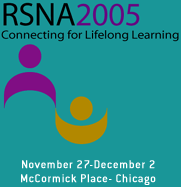
Abstract Archives of the RSNA, 2005
SSQ01-08
Computer-aided Detection (CAD) of Missed Breast Cancers by Mammographic Appearance and Lesion Size
Scientific Papers
Presented on December 1, 2005
Presented as part of SSQ01: Breast (Computer-assisted Detection)
Rachel Frydman Brem MD, Presenter: Nothing to Disclose
Jeffrey Worth Hoffmeister MD, Abstract Co-Author: Nothing to Disclose
Jocelyn A. Rapelyea MD, Abstract Co-Author: Nothing to Disclose
Steven W. Worrell, Abstract Co-Author: Nothing to Disclose
Jason Knapp, Abstract Co-Author: Nothing to Disclose
Martin P DeSimio PhD, Abstract Co-Author: Nothing to Disclose
Steven K Rogers PhD, Abstract Co-Author: Nothing to Disclose
et al, Abstract Co-Author: Nothing to Disclose
To evaluate the performance of a Computer-Aided Detection (CAD) system in the detection of breast cancers missed at screening mammography based on mammographic appearance and lesion size to assess the benefit of CAD in the earlier detection of breast cancer.
Eighteen centers enrolled 906 screen-detected breast cancer cases and 147 normal cases. Screening mammograms 9-24 months prior to cancer diagnosis were available in 374 cases and blindly reviewed by a panel of 3 radiologists. In 174 cases, one or more radiologist identified a mammographic abnormality with the appearance and location of the subsequently confirmed cancer. Mammographic lesion type and size were assessed for all 174 missed cancer cases. Architectural distortions and focal asymmetric densities were classified as masses. CAD (iCAD Second Look® system, version 7.0, high operating point) evaluated these 174 prior and 147 normal mammograms to assess the sensitivity of CAD for the detection of missed cancers and false positive (FP) rate.
CAD correctly marked 72% of the 174 missed cancer cases with an FP rate of 2.8 marks per 4-film case. Case sensitivities for missed microcalcifications based on size (20mm, n=11) and (all sizes, n=59) were 79%, 63%, 100%, 100% and 83%. Case sensitivities for missed masses based on size (20mm, n=9) and (all sizes, n=115) were 57%, 61%, 71%, 89% and 67%. There was no statistical difference in sensitivity based on lesion size for masses (p=0.12), but there was a difference for microcalcifications (p=0.004). The mean size of missed cancers manifesting as microcalcifications was 15mm (range 3-90mm) and for masses was 12mm (range 4-36mm).
The CAD system correctly marked 72% of breast cancers that had been missed at screening mammography, detecting 100% of missed microcalcifications larger than 10mm and showing no significant difference in performance based on missed mass size. CAD was effective in detecting even the smallest lesions, with sensitivities of 79% and 57% for missed microcalcifications and masses of 5mm or less. CAD helps to detect breast cancer earlier.
R.F.B.,S.K.R.: are consultants to iCAD, Inc.J.W.H.,S.W.W.,J.K.,M.P.D.: are employees of iCAD, Inc.
Brem, R,
Hoffmeister, J,
Rapelyea, J,
Worrell, S,
Knapp, J,
DeSimio, M,
Rogers, S,
et al, ,
Computer-aided Detection (CAD) of Missed Breast Cancers by Mammographic Appearance and Lesion Size. Radiological Society of North America 2005 Scientific Assembly and Annual Meeting, November 27 - December 2, 2005 ,Chicago IL.
http://archive.rsna.org/2005/4420458.html

